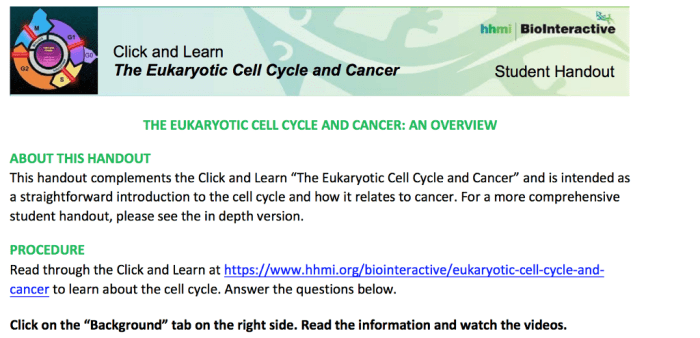Hhmi biointeractive the eukaryotic cell cycle and cancer answers – HHMI BioInteractive: Exploring the Eukaryotic Cell Cycle and Cancer delves into the intricate world of cell division, providing a comprehensive understanding of its mechanisms and implications in cancer development. This article unveils the stages of the eukaryotic cell cycle, highlighting the critical role of checkpoints in maintaining cellular integrity.
By examining how mutations disrupt these processes, we gain insights into the origins of uncontrolled cell division and the diverse types of cancer cells.
Furthermore, this article showcases HHMI BioInteractive’s invaluable resources, empowering educators with engaging materials to bring the complexities of the cell cycle and cancer to life in the classroom. These resources offer a wealth of interactive simulations, videos, and lesson plans, fostering a deeper understanding of these fundamental biological concepts.
Introduction

The eukaryotic cell cycle is a complex process that ensures the accurate division of cells. It is divided into four stages: G1, S, G2, and M. During G1, the cell grows and prepares for DNA replication. In S phase, the cell’s DNA is replicated.
During G2, the cell checks for errors in DNA replication and prepares for mitosis. Finally, during M phase, the cell divides into two daughter cells.
Checkpoints are critical control points in the cell cycle that ensure that the cell is ready to proceed to the next stage. If a checkpoint detects an error, it can stop the cell cycle and allow the cell to repair the error.
This helps to prevent the accumulation of mutations and the development of cancer.
Cancer and the Cell Cycle: Hhmi Biointeractive The Eukaryotic Cell Cycle And Cancer Answers

Mutations can lead to uncontrolled cell division, which is a hallmark of cancer. These mutations can occur in genes that encode proteins involved in the cell cycle, such as checkpoints and DNA repair proteins. When these proteins are mutated, they can no longer function properly, which can lead to the development of cancer.
There are many different types of cancer cells, each with its own unique set of mutations. Some cancer cells have mutations in genes that encode proteins involved in cell cycle regulation, while others have mutations in genes that encode proteins involved in DNA repair.
The type of mutation that a cancer cell has will determine its behavior and response to treatment.
There are a number of different cancer treatments that target the cell cycle. These treatments include chemotherapy, radiation therapy, and targeted therapy. Chemotherapy drugs work by damaging DNA, which can lead to cell death. Radiation therapy also damages DNA, but it can also damage other parts of the cell.
Targeted therapy drugs are designed to block specific proteins that are involved in the cell cycle. These drugs can be very effective in treating cancer, but they can also have side effects.
HHMI BioInteractive Resources

HHMI BioInteractive has a number of resources on the cell cycle and cancer. These resources include videos, animations, and interactives. These resources can be used in the classroom to help students learn about the cell cycle and cancer.
One of the most popular HHMI BioInteractive resources on the cell cycle is the “Cell Cycle and Cancer” video. This video provides an overview of the cell cycle and how mutations can lead to cancer. The video is clear and concise, and it is a great way to introduce students to the topic of cancer.
Another popular HHMI BioInteractive resource on cancer is the “CancerQuest” website. This website provides a wealth of information on cancer, including information on the cell cycle and cancer treatment. The website is easy to navigate, and it is a great resource for students and teachers alike.
FAQ Corner
What is the eukaryotic cell cycle?
The eukaryotic cell cycle is the process by which eukaryotic cells grow and divide. It consists of four distinct phases: G1, S, G2, and M.
How do mutations lead to uncontrolled cell division?
Mutations in genes that regulate the cell cycle can lead to uncontrolled cell division, which is a hallmark of cancer.
What are the different types of cancer cells?
There are many different types of cancer cells, each with its own unique characteristics. Some common types of cancer cells include carcinomas, sarcomas, lymphomas, and leukemias.
What are some examples of cancer treatments that target the cell cycle?
Some examples of cancer treatments that target the cell cycle include chemotherapy, radiation therapy, and targeted therapy.